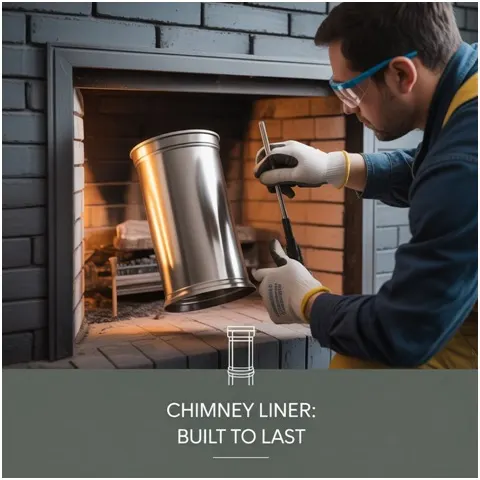In Saint Louis, ensuring proper functionality of heating systems during winter is essential. One of the most crucial yet overlooked components of chimney safety and efficiency is the Chimney Liner.
Why It Matters
It prevents excessive heat from damaging chimney walls, protects against corrosive byproducts, and improves draft performance. A well-installed liner also blocks carbon monoxide and smoke from leaking indoors. Building codes in Saint Louis mandate liners for any chimney venting fuel-burning appliances. Ignoring a damaged or missing liner can result in serious fire hazards, failed inspections, and higher repair costs.
Common Problems
Clay tile liners, commonly used in older Saint Louis homes, can crack under high heat and expansion. Stainless steel or aluminum liners may corrode when exposed to moisture or acidic flue gases. Common signs of liner failure include smoke escaping into the room, odors near the fireplace, and poor appliance performance. Without intervention, these issues can lead to creosote buildup, inefficient venting, and potential chimney fires. Timely replacement prevents structural and safety risks.
Key Features
Clay tile liners are affordable and fire-resistant but can be brittle and hard to replace in existing chimneys. Stainless steel liners are durable, corrosion-resistant, and flexible enough for retrofitting. Aluminum liners are lightweight and low-cost but suitable only for gas appliances.
Important attributes include UL listing for fire safety, proper sizing, and insulation.
Steps
The chimney liner replacement process in Saint Louis is a structured and safety-critical operation that must be done by certified professionals.
Step 1: Initial Inspection
A licensed chimney technician conducts a Level 2 video scan to assess the flue condition, check for cracks, and confirm liner size requirements.
Step 2: Selecting the Right Liner
Based on fuel type and chimney structure, the technician recommends an appropriate liner—often stainless steel for durability and versatility.
Step 3: Removing the Old Liner
If the current liner is damaged or obstructive, it is removed. Tile liners are broken out piece by piece, while metal liners are pulled through.
Step 4: Cleaning the Flue
Before installing the new liner, the chimney is cleaned of soot and debris to ensure a clear, smooth path.
Step 5: Installing the New Liner
The new liner is inserted, either rigid or flexible, depending on chimney design. Insulation may be wrapped or poured around the liner. It is then sealed and connected to the appliance.
Step 6: Testing and Cap Installation
Technicians run a draft test to verify proper ventilation. A chimney cap is installed to prevent debris, moisture, and animal entry.
Safety
Replacing a chimney liner requires technical expertise and must follow local fire codes. Mistakes in sizing or insulation can lead to chimney fires or carbon monoxide poisoning. It’s crucial to work with certified professionals.
According to Mark Reilly, a CSIA-certified technician, “Installing the correct liner is the most important safety upgrade for any chimney system. It prevents fire spread and ensures your system works efficiently.”
Professionals also guarantee code compliance and issue inspection certificates needed for insurance or real estate purposes.
Cost Breakdown
Costs for chimney liner replacement in Saint Louis vary by liner type, chimney height, fuel source, and labor. Here’s a breakdown:
| Liner Type | Estimated Cost (Installed) | Details |
| Clay Tile | $1,800 – $3,200 | Suitable for new builds; hard to retrofit |
| Aluminum | $1,200 – $2,500 | For gas appliances only; not corrosion-resistant |
| Stainless Steel (Flexible) | $2,000 – $4,500 | Ideal for retrofits and all fuel types |
| Stainless Steel (Rigid) | $2,500 – $5,000 | High performance for straight chimneys |
Disclaimer: Prices may change depending on flue condition, insulation needs, and contractor rates. Always request an in-person estimate from a licensed provider.
FAQs
Q: Is it mandatory to replace a damaged chimney liner?
Yes. Code requires a functional liner. If it’s cracked, missing, or deteriorated, replacement is necessary.
Q: How long do chimney liners last?
Stainless steel liners can last 20–25 years. Clay tile liners may last longer but are more fragile.
Q: Can I replace the liner myself?
DIY replacement is not recommended. It requires professional tools, code knowledge, and high safety risks.
Q: Can I install a new liner over the old one?
Sometimes. A new liner may be inserted if the old one isn’t blocked or deteriorating. This depends on chimney width and shape.
Q: How long does chimney liner replacement take?
Most jobs are completed within one day, though larger or complex chimneys may take longer.
Key Features
A proper chimney liner replacement should include:
- UL Certification for fire safety compliance
- Insulation for high-efficiency appliances and cold-weather performance
- Corrosion resistance to withstand acidic flue gases
- Right flexibility to accommodate bends and length
- Certified technician installation with safety testing and code compliance
Conclusion
In Saint Louis, replacing a chimney liner is more than a routine upgrade—it’s a vital home safety measure. The chimney liner replacement process involves inspection, careful material selection, flue preparation, and professional installation. It protects your property from fire, ensures proper appliance venting, and meets local building codes. With the right materials and expert service, you can extend the life of your chimney and keep your home safe, warm, and energy-efficient for years to come.
Read More: Chimney Sweep , digitaltrendreviews

